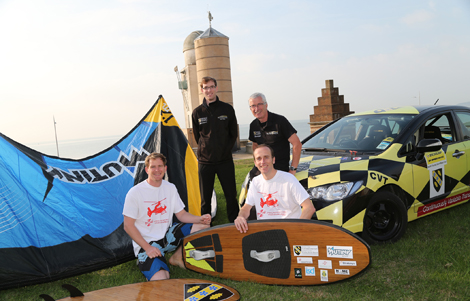
A team from University of Wales TSD Swansea are looking to kite surf across the Bristol Channel
This weekend you’ve probably a friend, relative or colleague doing something, somewhere for a charity – a noble deed, some exhausting act, or something simply ‘a bit daft’.
We’re a society that thrives on both pushing ourselves, and contributing to helping others less fortunate, which is why the task set by a group from University of Wales TSD Swansea’s product design course is so eye catching.
Harnessing the power of both sea and wind, five kite-surfers will attempt to cross the 33 mile Bristol Channel in a world’s first attempt – To put this into context, the English Channel (Dover-Calais) is a mere 21 miles.
The challenge sees the team use their product design expertise to completely re-design and manufacture a one-of-a-kind kitesurfing board using 3D printed parts for greater control, speed and technical reliability.
Producing a total four bespoke boards, the team 3D printed their parts on two Stratasys Fortus 250mc 3D Production System in collaboration with Stratasys reseller, Laser Lines. Utilising the systems’ ability to pair fine layer resolution with a large build envelope, the kite-surfers were able to fine-tune their designs and quickly print final parts for faster, more effective product testing and development.
The custom parts include newly designed board fins, with the team having adapted their size, shape, angles and fixings to better suit the sea and wind characteristics.
Wrapped in carbon fibre for stiffness, the 3D printed fins are considerably lighter than traditionally manufactured parts, enabling the team to travel at increased speeds as they take on their land opponent.
The kite-surfers also used 3D printed inserts to attach the foot straps to the board, designed to achieve the maximum strength possible as they are glued into the foam core.
Earlier this year we were contacted by Ross Head, product design manager at the university’s Cerebra design practise, as the team began planning the project, and have to admit, we thought the idea was crazy.
Since then the progress has been swift, and with the help of Stratasys the team is in the midst of final practices and watching the weather closely to pick the ideal date to set off.
“The use of 3D printing in product design, and especially in the extreme sport market, is revolutionising the manufacturing process and the speed to which companies can bring new products to market,” explains Ross. “We wanted our students to witness this first hand.”
As well as promoting the University of Wales, TSD Swansea, and its world first extreme sports engineering design course, the attempt is raising money for a good cause – the Wales Air Ambulance Charitable Trust.
To follow the progress of the event and watch the race live via GPS tracking, visit the team’s event page, or to help the team reach its fundraising target for the Wales Air Ambulance, click here.
It takes some effort even thinking of a challenge that’s never been done before, but also some balls to be responsible for designing, building and testing equipment needed to to it.
Best of luck to all involved from DEVELOP3D.






